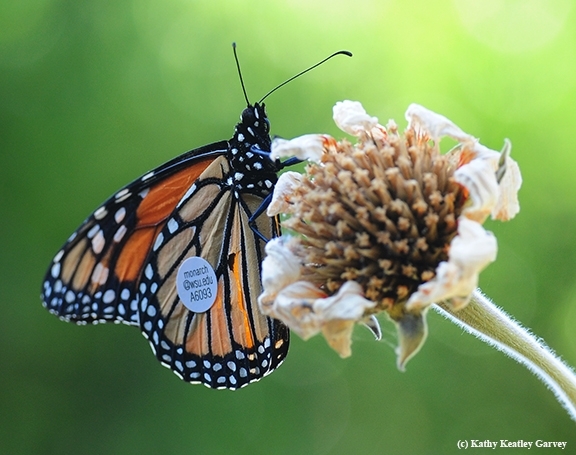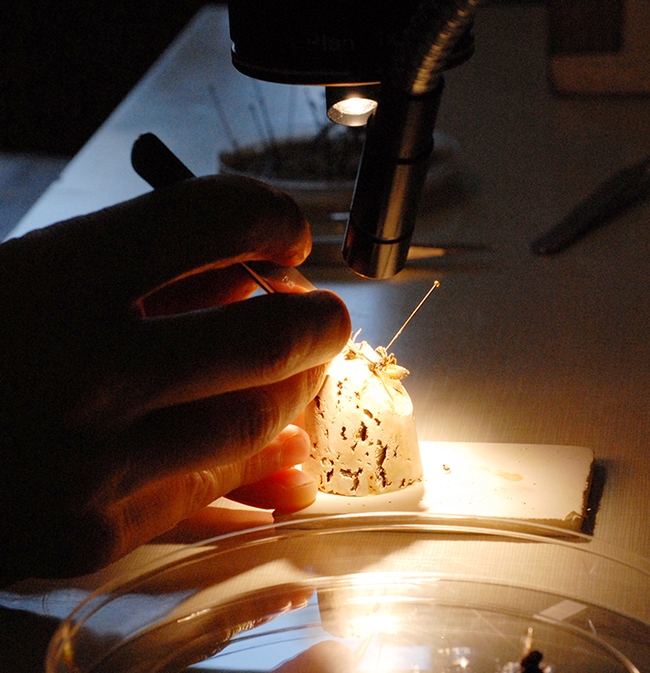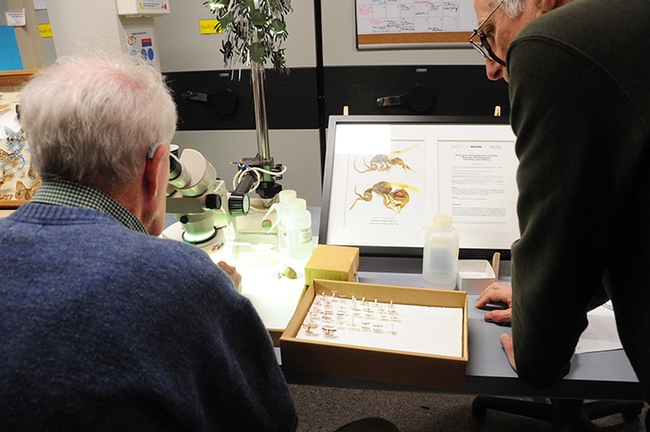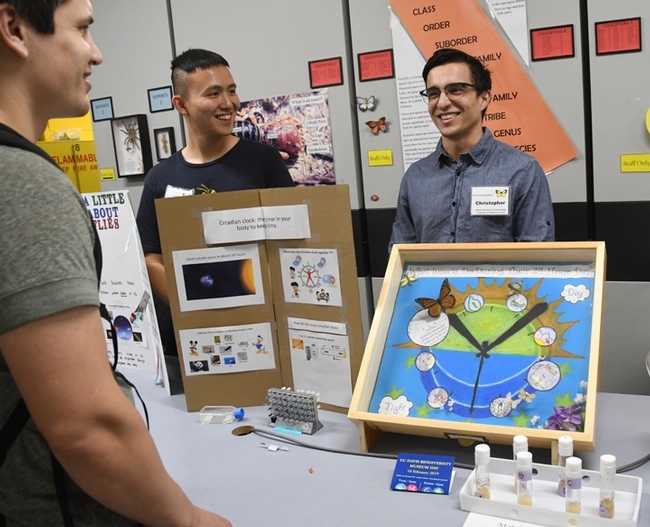
Take the case of a male monarch reared, released and tagged by Steven Johnson in a Washington State University citizen-science project operated by WSU entomologist David James. Johnson tagged and released the monarch on Sunday, Aug. 28, 2016 in Ashland, Ore. Seven days later, on Sept. 5, it fluttered into our family's backyard pollinator garden in Vacaville, Calif., where we photographed it.
"So, assuming it didn't travel much on the day you saw it, it flew 285 miles in 7 days or about 40.7 miles per day," James said. "Pretty amazing." (See Bug Squad blog)
But how do monarchs know when to migrate? You can find out when you attend the UC Davis Bohart Museum of Entomology open house on Saturday, Jan. 18 from 1 to 4 p.m. in Room 1124 of the Academic Surge Building, Crocker Lane.
Doctoral student Yao Cai, a fourth-year doctoral student in the Joanna Chiu lab who studies circadian clocks in insects, will relate how monarchs know when to migrate. “Using Drosophila melanogaster (fruit fly) and Danaus plexippus (monarch butterfly), as models, we seek to understand how these insects receive environmental time cues and tell time, how they organize their daily rhythms in physiology and behavior, such as feeding, sleep and migration (in monarch butterfly)," he says.
Cai is one of six doctoral students who will be showcasing their research. The event is free and family friendly.
Visitors not only will have the opportunity to talk to graduate students about their research and glean information about insects, but will be able see their work through a microscope. In fact, eight microscopes will be set up, Yang said.
In addition to Cai, doctoral students participating and their topics:
Ants: Zachary Griebenow of the Phil Ward lab, UC Davis Department of Entomology and Nematology
Assassin flies: Charlotte Herbert Alberts, who studies with major professor Lynn Kimsey, director of the Bohart Museum, UC Davis Department of Entomology and Nematology
Bats (what insects they eat): Ecologist Ann Holmes of the Graduate Group in Ecology, Department of Animal Science, and the Genomic Variation Laboratory, who studies with major professors Andrea Schreier and Mandi Finger.
Bark Beetles: Crystal Homicz. who studies with Joanna Chiu, UC Davis Department of Entomology and Nematology and research forest entomologist Chris Fettig, Pacific Southwest Research Station, USDA Forest Service, Davis.
Forensic entomology: Alexander Dedmon, who studies with Robert Kimsey, UC Davis Department of Entomology and Nematology
Some doctoral students also will deliver PowerPoint presentations or show slides. The projects:
Bark Beetles
“Did you know that between 1987 and 2017 bark beetles were responsible for more tree death than wildfire?” asks Crystal Homicz, a first-year doctoral student. “Bark beetles are an incredibly important feature of forests, especially as disturbance agents. My research focuses on how bark beetles and fire interact, given that these are the two most important disturbance agents of the Sierra Nevada. At my table, I will discuss how the interaction between bark beetles and fire, why bark beetles and fire are important feature of our forest ecosystem, and I will discuss more generally the importance of bark beetles in many forest systems throughout North America.
“I will have several wood samples, insect specimens and photographs to display what bark beetle damage looks like, and the landscape level effects bark beetles have. I will also have samples of wood damage caused by other wood boring beetles and insects. My table will focus widely on the subject of forest entomology and extend beyond beetle-fire interactions.”
Visitors, she said, can expect to leave with a clear understanding of what bark beetles are and what they do, as well as a deeper understanding of the importance of disturbance ecology in our temperate forests.
Assassin Flies
Charlotte Alberts, a fifth-year doctoral candidate, will display assassin flies and their relatives, as well as examples of prey they eat and/or mimic. Visitors can expect to learn about basic assassin fly ecology and evolution. Alberts studies the evolution of assassin flies (Diptera: Asilidae) and their relatives.
“Assassin flies are voracious predators on other insects and are able to overcome prey much larger than themselves,” she said. “Both adult and larval assassin flies are venomous. Their venom consists of neurotoxins that paralyze their prey, and digestive enzymes that allow assassin flies to consume their prey in a liquid form. These flies are incredibly diverse, ranging in size from 5-60mm, and can be found all over the world! With over 7,500 species, Asilidae is the third most specious family of flies. Despite assassin flies being very common, most people do not even know of their existence. This may be due to their impressive ability to mimic other insects, mainly wasps, and bees.”
For her thesis, she is trying to resolve the phylogenetic relationships of Asiloidea (Asilidae and their relatives) using Ultra Conserved Elements (UCEs), and morphology. "I am also interested in evolutionary trends of prey specificity within Asilidae, which may be one of the major driving forces leading to this family's diversity."
Bats
Ecologist Ann Holmes, a fourth-year doctoral student, is studying what insects that bats eat. "I will be talking about my research project that looks at insects eaten by bats in the Yolo Bypass. The insects eat crops such as rice, so bats provide a valuable service to farmers. Hungry bats can eat as much as their own body weight in insects each night."
"Visitors can expect to learn how DNA is used to detect insects in bat guano (poop)." "Insects in bat poop are hard to identify because they have been digested, but I can use DNA to determine which insects are there," she said. "We care about which insects bats eat because bats are natural pest controllers. With plenty of bats we can use less pesticide on farms and less mosquito repellent on ourselves."
Ants
Zachary Griebenow, a third-year doctoral student, will be showcasing or discussing specimens of the ant subfamily Leptanillinae, most of them male. “I will be showing specimens of the Leptanillinae under the microscope, emphasizing the great morphological diversity observed in males and talking about my systematic revision of the subfamily," he said. "In particular, I want to explain how the study of an extremely obscure group of ants can help us understand the process of evolution that has given rise to all organisms."
Forensic Entomology
Forensic entomologist Alex Dedmon, a sixth-year doctoral student, will display tools and text and explain what forensic entomology is all about. "My research focuses on insect succession. In forensic entomology, succession uses the patterns of insects that come and go from a body. These patterns help us estimate how long a person has been dead. Visitors can expect to learn about the many different ways insects can be used as evidence, and what that evidence tells us."
Other Open House Activities
The family craft activity will be painting rocks, which can be taken home or hidden around campus. "Hopefully some kind words on rocks found by random strangers can also make for a kinder better future,” said Yang.
In addition to meeting and chatting with the researchers, visitors can see insect specimens (including butterflies and moths), meet the critters in the live “petting zoo” (including Madagascar hissing cockroaches, walking sticks and tarantulas) and browse the gift shop, containing books, insect-themed t-shirts and sweatshirts, jewelry, insect-collecting equipment and insect-themed candy.
The Bohart Museum, directed by Professor Lynn Kimsey and founded by noted entomologist Richard M. Bohart (1913-2007), houses a global collection of nearly eight million specimens. It is also the home of the seventh largest insect collection in North America, and the California Insect Survey, a storehouse of insect biodiversity.
The insect museum is open to the public Mondays through Thursdays from 9 a.m. to noon and 1 to 5 p.m., except on holidays. More information on the Bohart Museum is available on the website at http://bohart.ucdavis.edu or by contacting (530) 752-0493 or bmuseum@ucdavis.edu.
Attached Images:

Eight microscopes will be available at the Bohart Museum of Entomology open house on Jan. 18. Visitors can view the research projects of doctoral students. (Photo by Kathy Keatley Garvey)

Ants will be the topic of Zachary Griebenow of the Phil Ward lab, UC Davis Department of Entomology and Nematology. This image shows emeritus professor Jerry Powell of UC Berkeley identifying insects at the Bohart Museum of Entomology. (Photo by Kathy Keatley Garvey)
